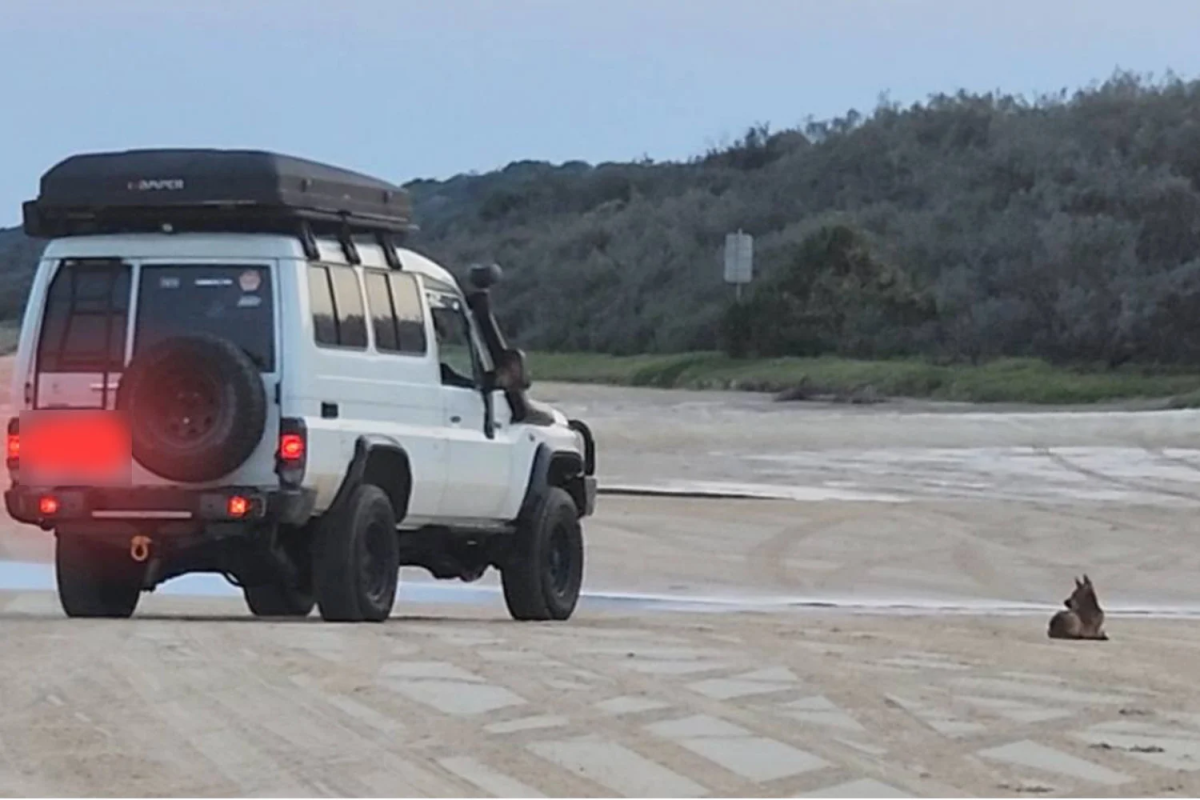
The pristine sands of K'gari hide a growing danger—one fuelled not by nature, but by human recklessness.
Tourists, eager for the perfect social media shot, are getting dangerously close to the island’s wild dingoes, sparking a rise in attacks that have left locals and rangers alarmed.
Authorities now fear that the next encounter could turn deadly—for both humans and these iconic animals.
K'gari’s breathtaking beauty continues to attract hundreds of thousands of visitors each year, but 2024 has seen a troubling surge in serious incidents between tourists and the island’s native dingoes.
Rangers have already responded to 16 serious cases this year, nine involving children, including a four-year-old girl who was flown to hospital in August after being bitten on the chest while her family was fishing.
It’s not just the number of attacks that’s shocking, but the cause behind them—reckless tourist behaviour.
Eyewitnesses have captured visitors driving 4WDs and tour buses dangerously close to dingo pups, some getting within two metres to take photos and videos for social media.
'This is getting to the stage where it is frightening, whether the next one will be a fatality or not.'
The reckless scenes have been most distressing during pupping season, when dingo families are at their most vulnerable.
A local business owner described vehicles crowding the pups, stopping them from playing as they cowered in fear each time cars approached.
'It was terrible, they couldn't do their puppy play, as each time they stopped playing as the cars drove close and scared them,' the witness said. 'This is really dangerous for them too; they could walk under and get burnt or get run over as you drive off.'
Some visitors are even deliberately feeding the dingoes, despite knowing the dangers.
One ranger recalled booking a tourist who responded, ‘It was worth it’—a remark that epitomises the careless attitude threatening the island’s fragile ecosystem.
Recognising the crisis, the Queensland Government has announced $2 million in additional funding this financial year and $3 million annually ongoing to boost conservation efforts.
The funds will expand proactive safety messaging and support 13 new roles focused on dingo management and protection.
Fines for disturbing or feeding dingoes are steep—on-the-spot penalties of $2,670 and court fines up to $27,538.
In 2024 alone, more than 20 fines have been issued, including at least nine for deliberate feeding or interaction, amid over 130 high-risk encounters between humans and dingoes.
Understanding K'gari's cultural significance
For thousands of years, the Butchulla people lived alongside K'gari's dingoes in harmony.
They distinguished between 'wat'dha' (camp dingoes) that were companions helping with hunting and protection from bad spirits, and 'wongari' (wild dingoes) that roamed the coastline.
When the last Indigenous people were removed from the island, all the dingoes became wild, making today's human-dingo interactions particularly complex.
With around 500,000 tourists visiting annually and roughly 180 dingoes on the island, the pressure on the ecosystem is immense.
Conservation advocate Cheryl Bryant said that during peak seasons, 'the island, the east coast, gets saturated with tourists. It's impossible for the dingoes living in that area to avoid people.'
Senior ranger Linda Behrendorff has noticed worsening behaviour since the pandemic, particularly from inexperienced 4WD owners who often drink heavily and ignore safety rules.
In January 2024, a tagged dingo had to be euthanised after several attacks on children and a man—an outcome that wiped out one per cent of the entire island’s dingo population.
The loss of each animal represents a significant blow to the gene pool, further threatening the long-term survival of this protected species.
Adding to the heartbreak, reports have surfaced of dingoes being intentionally harmed—one found decapitated, another killed by a vehicle and left in a pool of blood.
Experts say these incidents highlight a grim pattern: when dingoes are fed or exposed to human food waste, they lose their natural wariness and begin to see people as competition rather than danger.
Essential dingo safety guidelines
- Stay at least 20 metres (four car lengths) away from all dingoes
- Keep children within arm's reach at all times
- Carry a safety stick such as a hiking pole or umbrella
- Never run or jog alone—dingoes may chase
- Dispose of all food waste properly in locked containers
- Never feed or interact with dingoes under any circumstances
- Don't bring food onto beaches or lake shores where dingoes frequent
Rangers now urge visitors to travel in groups, remain alert, and carry deterrents such as ‘dingo sticks’ to reduce risk—especially for families with young children.
Authorities stress that the dingoes of K'gari are a national treasure, and that human habituation poses the greatest threat to their survival.
As one conservation group put it, 'You're much more likely to be in a car accident, eaten by a shark, [or] to drown than be attacked by a dingo'—but only if visitors follow the rules that keep both species safe.
For travellers planning to visit this World Heritage site, remember that K'gari is their home first and your holiday second.
Your behaviour could determine whether these magnificent animals thrive—or vanish forever.
What This Means For You
In 2024 alone, authorities responded to 16 serious dingo incidents on K'gari, nine of which involved children. The Queensland Government has since invested an extra $5 million to protect and manage the island’s dingo population, as feeding or disturbing these wild animals can result in fines of up to $27,538.
Experts warn that as more tourists ignore safety rules, the dingoes’ natural behaviour continues to change—putting both people and the species at risk. For travellers who’ve spent a lifetime exploring Australia’s great outdoors, this is a sobering reminder that respecting wildlife isn’t just about following the rules—it’s about ensuring these creatures are still around for future generations to admire.
If this story about reckless tourist behaviour on K'gari has you wondering just how widespread the problem is, you’re not alone.
Another popular island destination is facing the same frustration, as locals grow increasingly alarmed by visitors who ignore safety warnings and put both themselves and wildlife in danger.
It’s a stark reminder that respect for nature isn’t optional—it’s essential to preserving the places we love to explore.
Photos expose ‘terrible’ 4WD behaviour on popular Aussie island risking $2,670 fines — Shocking images reveal tourists driving dangerously close to K’gari’s dingoes despite strict safety warnings.
https://au.news.yahoo.com/photos-expose-terrible-4wd-behaviour-on-popular-aussie-island-risking-2670-fines-001555723.html
Latest spate of dingo attacks on K’gari may see tourists banned from popular spot — Rangers responded to 16 serious incidents in 2024, nine involving children, prompting possible restrictions on island access.
https://www.indailyqld.com.au/news/archive/2024/08/27/latest-spate-of-dingo-attacks-on-kgari-may-see-tourists-banned-from-popular-spot
16 Dingo Attacks This Year Prompt Possible Camping Bans at World Heritage Site — A rise in ‘high-risk’ encounters sparks concerns about tourist behaviour endangering both people and dingoes.
https://gearjunkie.com/camping/dingo-attacks-world-heritage-site-kgari
Tourists taking selfies and feeding dingoes blamed for rise in K’gari attacks — Rangers and conservationists warn that feeding and disturbing dingoes are fuelling aggression and endangering the species.
https://animalsurvival.org/trade-and-legislation/tourists-taking-selfies-and-feeding-dingoes-blamed-for-rise-in-kgari-attacks/
Tourists bitten by wongari on K’gari | Department of the Environment, Tourism, Science and Innovation (DETSI), Queensland — Government authorities confirm new safety funding and detail fines for feeding or disturbing dingoes.
https://www.detsi.qld.gov.au/our-department/news-media/mediareleases/2024/tourists-bitten-by-wongari-on-kgari
Dingo euthanised on K’gari following dangerous incidents | Department of the Environment, Tourism, Science and Innovation (DETSI), Queensland — A tagged dingo was euthanised after several attacks, representing a loss of one per cent of the island’s population.
https://www.detsi.qld.gov.au/our-department/news-media/mediareleases/2024/dingo-euthanised-on-kgari-following-dangerous-incidents
Australia’s K’gari, Fraser Island Rangers Issue Urgent Safety Warning Amid Rising Dingo Incidents and Increasing Tourist Arrivals — Rangers urge visitors to stay in groups and carry ‘dingo sticks’ amid record tourist numbers and heightened risks.
https://www.travelandtourworld.com/news/article/australias-kgari-fraser-island-rangers-issue-urgent-safety-warning-amid-rising-dingo-incidents-and-increasing-tourist-arrivals/
Dingo attack — Wikipedia — Research shows that feeding dingoes or exposing them to human food waste makes them lose caution and act aggressively.
https://en.wikipedia.org/wiki/Dingo_attack
Dingos—K'gari (Fraser Island) Forum—Tripadvisor — Visitors discuss fines and frequent dingo encounters, citing over 130 high-risk incidents in 2024.
https://www.tripadvisor.com.au/ShowTopic-g255078-i2048-k14465870-o10-Dingos-K_gari_Fraser_Island_Fraser_Coast_Queensland.html
Have you ever witnessed tourists acting recklessly around wildlife? What do you think should be done to better protect Australia’s native animals?







